What is the circle offense
The circle offense is a basketball offensive strategy that utilizes cuts and continuity patterns to create scoring opportunities near the basket.
Additionally, the circle offense features five players which fill five perimeter spots near the top, the wings, and the corners, similar to the standard 5 out motion offense.
The main sequence of the circle offense is to have at least three players in constant motion at all times. When this occurs, particularly in a continuous fashion, the defense could potentially breakdown, which in turn, would lead to scoring opportunities.
The circle offense could be beneficial for undersized or guard-oriented offensive teams and/or useful against defensive teams with average to below average defensive IQ.
Additionally, the circle offense includes backdoor cuts as a counter option if the opposing team executes denial defense.
Furthermore, it could also be used as a possible delay offense in order to run time off of the game clock while the players are in continuous motion.
What are general principles to consider for the circle offense
Create good spacing
All players should be about 12 to 15 feet apart to create good spacing on the court. This will help the offensive players to have better opportunities to cut, particularly to the basket.
Also, at the same time, it could become more challenging for the defensive team to execute tactics such as help defense.
Constant motion
At least three players should always be in constant motion which could increase the chance to cause defensive breakdowns.
Backdoor cut when denied
If the defensive team denies the ball with a hand in the passing lane, then players should execute a backdoor cut towards the basket.
What is an example of the basic continuity within the circle offense
Basic Continuity – Part 1

This is an example of the basic continuity within the circle offense that features a top to wing pass and various cuts from the top, weak side wing, and weak side corner.
To start, 2 receives the ball from 1. Following that, 1 executes a shallow cut near the left side high post and then pops out to the left side wing.
At the same time, 3 executes a cut behind 1 towards the basket. Furthermore, as that happens, 4 cuts behind 3 towards the top.
If 3 is open on the cut towards the basket, then 3 could receive the ball from 2 and score with a layup. If 3 is not open, then 3 continues to cut out towards the left side corner.
Related: Coach Pennell GCU Circle Offense – YouTube
Related: 5 Out Circle Motion Continuity Offense – YouTube
Basic Continuity – Part 2
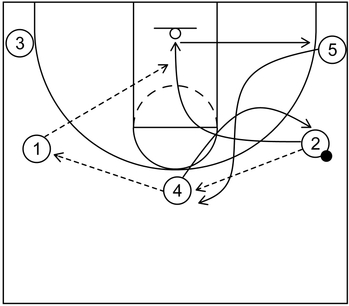
Next, the continuity sequence can begin and the action could run again on the other side. To start, 4 receives the ball from 2 and then 1 receives the ball from 4.
After the ball reversal occurs, 4 executes a shallow cut to the right side high post and then pops out to the right side wing.
As that happens, 2 executes a cut behind 4 towards the basket. Also, at the same time, 5 cuts behind 2 towards the top. If 2 is open on the cut to the basket, then 2 could receive the ball from 1 and score with a layup.
If 2 is not open, then 2 continues to cut out towards the right side corner. Afterwards, the continuity could get executed again with ball reversal toward the right side of the floor.
What are examples of basic counters for the circle offense
Denial Defense at Top – Example 1
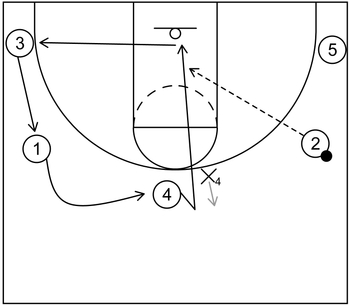
This is an example of a counter option within the circle offense when denial defense occurs at the top.
To start, 4 is not able to receive the ball from 2 because X4 executes denial defense with a hand in the passing lane, represented by the gray arrow.
When that occurs, 4 executes a backdoor cut to the basket, receives the ball from 2, and scores with a layup. If 4 is not open to receive the ball, then 4 continues the cut out to the left side corner.
At the same time, 1 cuts to the top and 3 cuts to the left side wing. Afterwards, the circle offense could continue with 1 receiving the ball from 2 and so forth.
Denial Defense at Top – Example 2
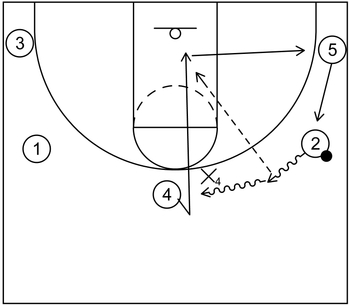
This is yet another example of a counter against denial defense that occurs at the top. To begin, 4 is not open to receive the ball from 2 because of the denial defense by X4.
When that occurs, 2 begins to dribble at 4. This initiates an automatic backdoor cut to the basket by 4. From there, 4 could receive the ball from 2 and score with a layup if that is open.
If 4 is not open to receive the ball, then 4 will continue the cut out towards the right side corner. At the same time, 5 will fill the right side wing and 2 will continue to dribble to the top.
Afterwards, the circle offense could continue with 1 (or 5) receiving the ball from 2.
Denial Defense on Wing – Part 1
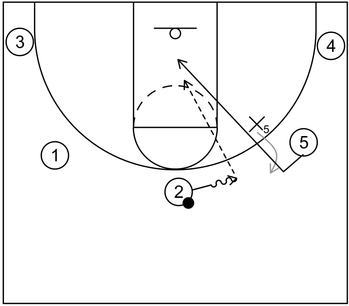
This is an example of a counter within the circle offense when denial defense occurs on the wing. To start, 5 is not able to receive the ball from 2 because X5 executes denial defense with a hand in the passing lane, represented by the gray arrow.
When that occurs, 2 dribbles at 5 which initiates an automatic backdoor cut to the basket by 5. From there, 5 could receive the ball from 2 and score with a layup if that is open.
Denial Defense on Wing – Part 2
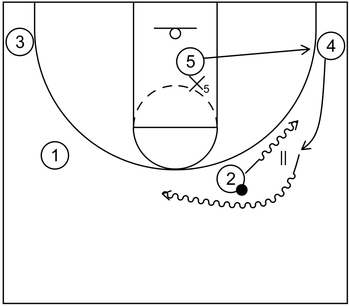
If 5 is not open to receive the ball from 2, then 5 can continue the cut out towards the right side wing. As that occurs, 4 cuts to the wing to execute dribble hand-off action with 2.
Next, 4 dribbles back to the top. After that, the circle offense could continue with 1 receiving the ball from 4.
What are examples of variations for the circle offense
Down Screen
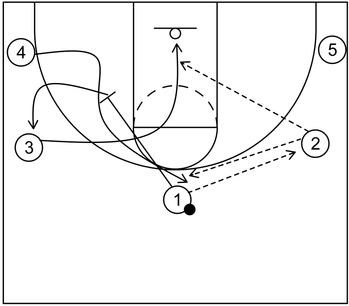
This is an example of a variation for the circle offense which features a down screen by the first passer instead of the shallow cut to the high post. To begin, 2 receives the ball from 1 and after that, 1 cuts down near the mid-post block to set a down screen.
At the same time, 3 cuts behind 1 to the basket while 4 cuts to the top from the down screen. Following that, 3 could receive the ball from 2 and score near the basket.
Conversely, 4 could receive the ball from 2 and take the jump shot if open or reverse the ball to 1 who filled the left side wing after setting the down screen.
If 1 receives the ball, then 3 would cut out to the left side corner and the offensive players could continue to execute the basic actions of the circle offense.
Ball Screen – Part 1
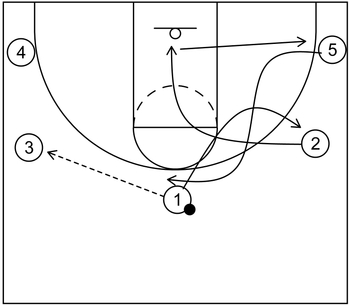
This is an example of a variation for the circle offense which includes a side ball screen.
With this variation, the offensive sequence begins as normal but this time, the player that comes from the opposite corner to the top will set an on-ball screen instead of receiving the reversal pass.
To start, 3 receives the ball from 1. Following that, 1 executes a shallow cut to the right side high post and then cuts out to the right side wing.
At the same time, 2 executes a cut behind 1 to the basket. Furthermore, 5 cuts behind 2 towards the top.
Ball Screen – Part 2

Next, 3 dribbles toward the top via the on-ball screen set by 5 who also rolls to the basket. Following that, 5 could receive the ball from 3 and score near the rim if that is open.
Otherwise, 1 could receive the ball from 3, and after that, 5 could cut out to the left side corner while 4 fills the left side wing. From that point, the offensive players could execute the basic actions of the circle offense.